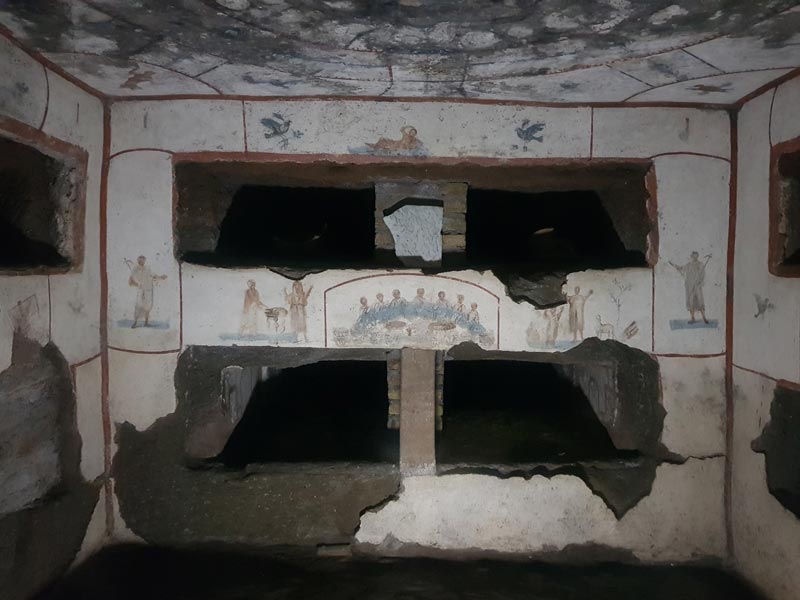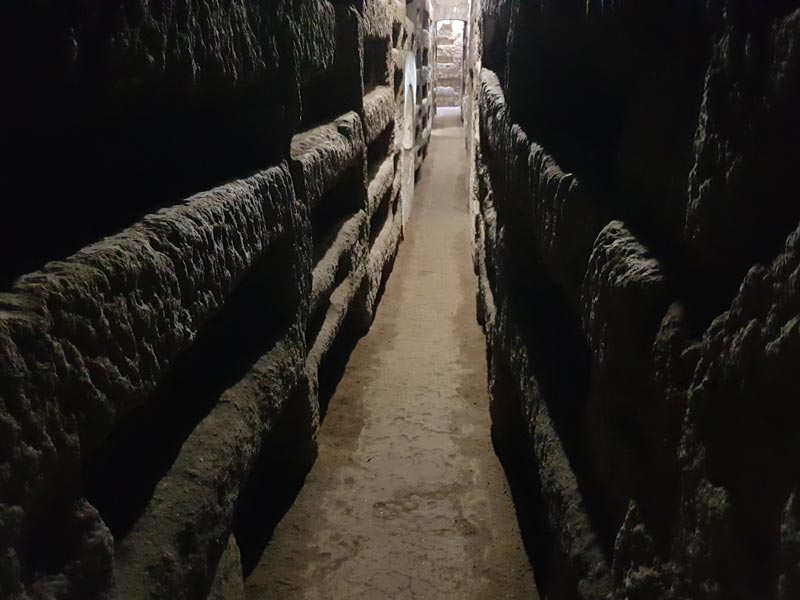欧博官网The Catacombs of Saint Callixtus
Home

Hours

Directions

Tickets

Reservations

Guidelines







Italiano
English
Español
Deutsch
Français
Polski
Nederlands
The Catacombs of Saint Callixtus
They are on the right of the Appian Way, after the church of "Quo Vadis?".
The catacombs of St. Callixtus are among the greatest and most important of Rome. They originated about the middle of the second century and are part of a cemeterial complex which occupies an area of 90 acres, with a network of galleries about 12 miles long, in four levels, more than twenty meters deep. In it were buried tens of martyrs, 16 popes and very many Christians.

In the open area are two small basilicas with three apses, known as the "Trichorae". In the Easter one were perhaps laid to rest pope Zephyrinus and the young martyr of the Eucharist, St. Tarcisius.
The underground cemetery includes several areas. The area of the Popes is the most important and venerated crypt of the cemetery, called "the little Vatican" as it was the official burial place of nine popes and, probably, of eight dignitaries of Rome's 3rd century Church. In the walls you can still see the original inscriptions, in Greek, of five popes. On four tombstones, near the name of the pope, there is the title of "bishop", since the Pope was regarded as the head of the Church of Rome, and on two of them there is the Greek abbreviation of MPT for "Martyr".
The Crypt of St. Cecilia: the popular patron saint of music. Of a noble Roman family, she was martyred in the 3rd c. and entombed where the statue now lies.
She was venerated in this crypt for at least five centuries. In 821 her relics were transferred to Trastevere, in the basilica dedicated to her.
The statue of St. Cecilia is a copy of the celebrated work sculptured by Stefano Maderno in 1599.
The crypt was all covered with mosaics and paintings (beginning of the IX Century). On the wall, near the statue, we see an ancient painting of St. Cecilia in an attitude of prayer; lower down, in a small niche, is a fresco representing Christ holding a Gospel. On the right side is the figure of St.Urban. On the wall of the shaft is the painting of three martyrs: Polycamus, Sebastian and Quirinus.
Passing through imposing galleries full of loculi, we reach five small chambers, truly family tombs, commonly known as the cubicles of the Sacraments, and particularly important for their frescoes. The frescoes can be dated to the beginning of the III century and represent symbolically the sacraments of Baptism and of the Eucharist. We find depicted also the prophet Jona, a symbol of the resurrection.
The origins of Catacombs
In the first century Rome's Christians did not have their own cemeteries.If they owned land, they buried their relatives there, otherwise they resorted to common cemeteries, where pagans too were buried. That is how Saint Peter came to be buried in the great public "necropolis" ("city of the dead") on Vatican Hill, available to everybody. Likewise Saint Paul was buried in a necropolis along the Via Ostiense.

With the edict of Milan, promulgated by the emperors Constantine and Licinius in February 313, the Christians were no longer persecuted. They were free to profess their faith, to have places of worship and to build churches both inside and outside the city, and to buy plots of land, without fear of confiscation. Nevertheless, the catacombs continued to function as regular cemeteries until the beginning of the fifth century, when the Church returned to bury exclusively above ground or in the basilicas dedicated to important martyrs.
When the barbarians (Goths and Longobards) invaded Italy and came down to Rome,they systematically destroyed a lot of monuments and sacked many places, including the catacombs. Powerless in the face of such repeated pillages, towards the end of the eighth century and the beginning of the ninth, the Popes ordered to remove the relics of the martyrs and of the saints to the city churches, for security reasons.
When the transfer of the relics was completed, the catacombs were no longer visited; on the contrary, they were totally abandoned, with the exception of Saint Sebastian, Saint Lawrence and of Saint Pancratius. In the course of time, landslides and vegetation obstructed and hide the entrances to the other catacombs, so that the very traces of their existence were lost. During the late Middle Ages they didn't even know where they were.
The exploration and scientific study of the catacombs started, centuries later, with Antonio Bosio (1575-1629), nicknamed the "Columbus of subterranean Rome". In the last century the systematic exploration of the catacombs, and in particular of those of Saint Callixtus, was carried out by Giovanni Battista de Rossi (1822-1894), who is considered the father and founder of Christian Archaeology.
In 1930 the Holy See, as the owner of the Catacombs, entrusted the catacombs of St. Callixtus to the care of the religious Congregation of the Salesians of Don Bosco.
booking form

Catacombe di San Callisto
Via Appia Antica, 110
00179 ROMA - Italy
Tel. +39 - 06 - 513 01 51
Fax +39 - 06 - 513 01 567
info@catacombesancallisto.it

Istituto Salesiano San Callisto - Roma - Codice Fiscale 01053640585